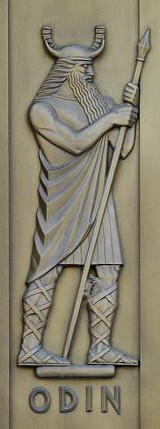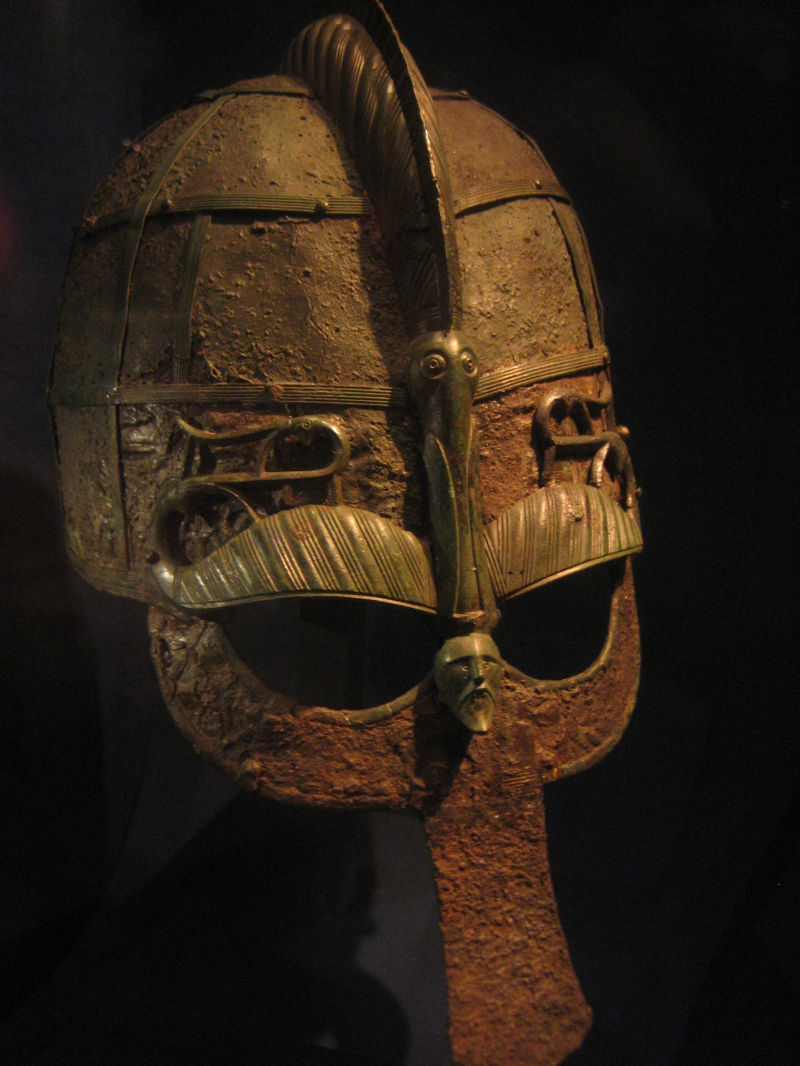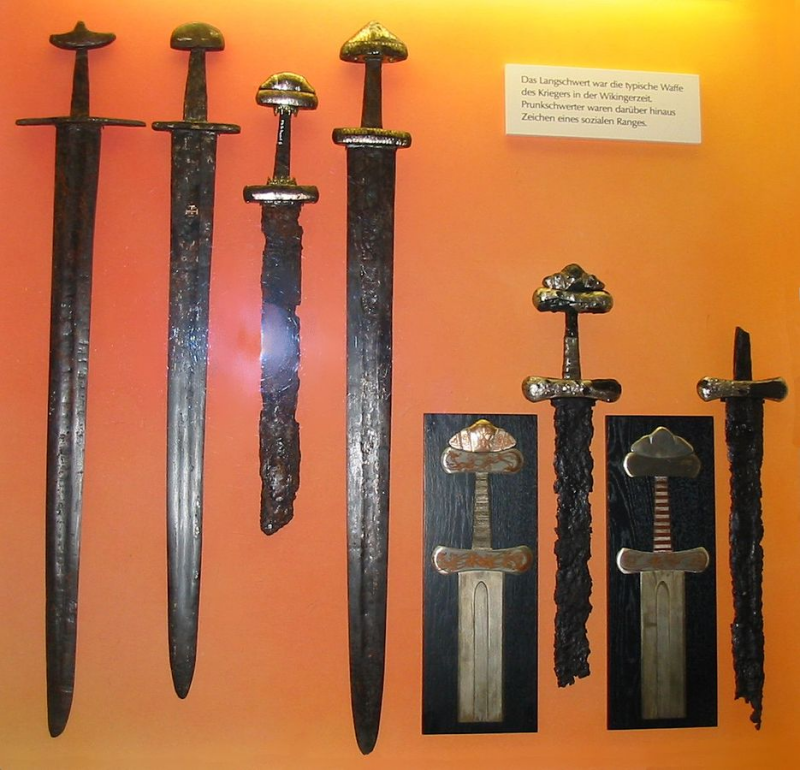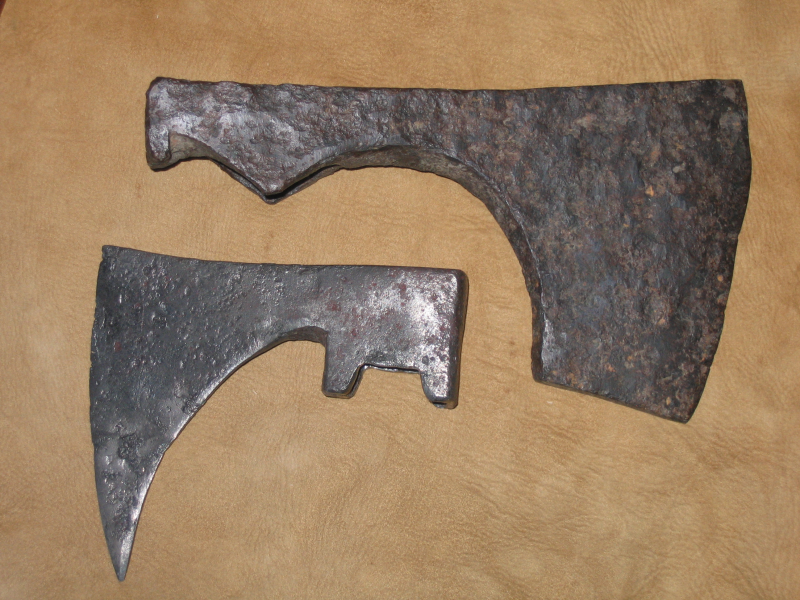VIKING WEAPONS AND ARMOR (SWORDS, AXES, SPEARS, ETC.)
In the Viking Age, free men (all men who weren’t slaves) had not only the right to own and carry weapons, but the duty to do so.[1] This was not only for their own protection, but for the defense of their families and communities as well. After all, in the Viking Age, you couldn’t lay your guard down for long without paying the price.
Poorer men would have had only an ax and a shield, whereas wealthy men would have also had a helmet, a coat of mail, a sword, and a spear.[2]
Our knowledge of Viking weapons comes chiefly from archaeological finds. Weapons were often buried with their owner as grave goods, and offerings of weapons – probably made to one of the many Scandinavian war gods – were deposited in bogs and lakes, where they can be recovered today. Literary sources help to round out the picture.[3]
Viking Swords
Swords were the quintessential prestige weapon in Norse society. To be given a sword was to become more or less officially part of the social elite.[4] Viking poetry, which was usually composed to praise chieftains and kings, frequently mentions the swords of the ruler and his finest warriors, to underscore their social standing and prowess in battle. There were several kennings – complex stock images poets used to demonstrate their erudition – for swords, including “snake of wounds” and “flame of Odin.”[5]
Historian H.R. Ellis Davidson ably summarizes the social importance of the sword in Viking society:
The sword was closely associated with much of what was most significant in a man’s life – family ties, loyalty to his lord, the duties of a king, the excitement of battle, the attainment of manhood, and the last funeral rites. It was something from which its owner was never parted throughout his life, from the moment he had received it and had the right to wear it. He carried it in the king’s hall and at law meetings, although on such occasions it was forbidden to draw it, and it might be fastened down in the scabbard. At night it hung above his bed, as we know from Beowulf and the Icelandic sagas. A sudden attack often came at night, and to lose hold of one’s sword, as King Aethelstan discovered, was a terrifying experience… It was indeed, as is said in one of the Anglo-Saxon riddles, the prince’s “shoulder-companion,” his close friend ever at his side, and the “warrior’s comrade.” Small wonder that Bersi the Dueller, famous swordsman and poet of the tenth century, declared that if he could no longer wield his sword, his life held nothing more for him… For a man who could no longer rely upon his sword had become a nonentity, a helpless figure relying on others for the protection of life, property, and reputation. The time had come to hand over the guardianship of the family, with the sword, to his descendants.[6]
In the early Viking Age, sword blades were sometimes single-edged, a continuation of the tradition of the Germanic sax. As the Viking Age progressed, however, double-edged swords increasingly took their place. The iron blades of Viking swords typically had a “fuller,” a broad, shallow groove that runs along the center of the blade, a feature intended to make the sword lighter and easier to handle.[7]
The simplest hilts were often made of antler, while the most lavish ones were often made of silver or gold and richly decorated. Counterweights called “pommels” were attached to the end of the hilt, and were usually made of iron or cast copper alloy. Iron fittings with various designs added an artistic, personalized touch to the hilts. Including both the hilt and the blade, Viking swords were typically around 90 cm long.[8][9]
Scabbards were made of wood or leather, and were often lined with wool or fabric.[10]
Especially fine and unique swords sometimes had names, such as Brynjubítr (Old Norse “Mail-biter”) or Gullinhjalti (“Golden-hilt”).[11]
Viking Axes
Whereas swords were prestige weapons, axes were the weapon of the “common man” in the Viking Age.[12] Axes were made of iron, and since they were tools as well as weapons, they were usually quite plain and utilitarian. However, copper, silver, or even gold decorations weren’t unheard-of. Battle axes – axes specifically designed for use in warfare – were distinguished from regular axes by their especially broad blades and projecting spurs. But the axes of the period came in all kinds of different shapes and sizes – small, large, broad, slender, light, heavy, with large spurs, with small spurs, with no spurs at all, and so forth.[13]
One of the most famous Viking axes is “Hel” (named after the Norse death goddess), which belonged to King Magnus of Norway and Denmark. He is said to have inherited the weapon from his father, Olav Haraldsson of Norway, whose ax features prominently in Norway’s national coat of arms. Some Viking axes – if they were wielded by a particularly strong and skilled warrior – could even cut through chainmail and helmets. When King Magnus’s poet credited the king with being able to split heads like firewood, he wasn’t necessarily being hyperbolic.[14]
Viking Spears

Odin with his spear Gungnir in the Library of Congress
There were two kinds of Viking spears: heavy throwing spears and lighter thrusting spears.[15] The former were more common than the latter, however. The spearheads were made of iron and sometimes contained designs in copper or silver worked into their sockets. They could be up to half a meter long. They were most commonly leaf-shaped, had shoulders that could be rounded or angular, and possessed a rib along their center. Rivets attached them to the shaft. Sometimes these rivets were more extensive than necessary, which provided an opportunity to include more decoration. Shafts could be up to two meters long, and ash was the preferred wood used to make them due to its flexibility and strength.[16][17]
Viking spears were sometimes cast over an enemy host at the outset of a battle, in imitation of Odin’s paradigmatic throwing of his spear Gungnir in the gods’ first war,[18] and as a way of sacrificing the enemy army to Odin.
Viking Bows and Arrows
Bows and arrows were the fourth major type of Viking weapon, in addition to axes, swords, and spears. Bows were made of wood, arrowheads of iron, flight-ends of feathers, and quivers of wood or leather. Bows and arrows made for hunting were often decorated with metal fittings, unlike their cousins designed for use in war, which were far harder to recover once shot and therefore less rewarding to decorate.[19]
Viking Shields, Helmets, and Other Defensive Equipment

A Vendel-era helmet from Sweden (photo by Mararie)
Since Viking shields were made of wood, few have survived in the archaeological record, so our knowledge of Viking shields comes primarily from Viking Age pictures of them and literary descriptions.[20]
Viking shields were made of wood with iron bosses that covered the hand-grip to protect the hand. The grip itself was usually made of wood, but sometimes metal was used instead. Some shields had metal rims around their edges. Shields were decorated with paints, often brightly colorful ones. As Norse poetry attests, shields could also feature pictures of mythical motifs. Some shields had leather coverings for extra strength. The diameter of a typical Viking shield was a little less than a meter.[21][22][23]
The Vikings commonly wore helmets in battle. Their helmets were sometimes made of iron, and sometimes just leather,[24] which was better than nothing, at least. Helmets were conical or rounded in shape, and many had nose-guards.[25]
Due to the expense involved in making chainmail, only wealthy Vikings could afford it.[26] Chainmail shirts probably extended down to the knees, and were long-sleeved.[27]
Want to learn more about Viking weapons and armor, and the Vikings in general?
My list of The 10 Best Books on the Vikings will surely prove helpful to you.
References:
[1] Roesdahl, Else. 1998. The Vikings. p. 142.
[2] Wolf, Kirsten. 2004. Viking Age: Everyday Life During the Extraordinary Era of the Norsemen. p. 159.
[3] Ibid.
[4] Winroth, Anders. 2014. The Age of the Vikings. p. 31.
[5] Wolf, Kirsten. 2004. Viking Age: Everyday Life During the Extraordinary Era of the Norsemen. p. 159.
[6] Ibid. p. 160.
[7] Pedersen, Anne. 2012. Viking Weaponry. In The Viking World. Edited by Stefan Brink and Neil Price. p. 204.
[8] Ibid.
[9] Roesdahl, Else. 1998. The Vikings. p. 142.
[10] Ibid.
[11] Ibid.
[12] Winroth, Anders. 2014. The Age of the Vikings. p. 24.
[13] Pedersen, Anne. 2012. Viking Weaponry. In The Viking World. Edited by Stefan Brink and Neil Price. p. 206.
[14] Winroth, Anders. 2014. The Age of the Vikings. p. 26.
[15] Wolf, Kirsten. 2004. Viking Age: Everyday Life During the Extraordinary Era of the Norsemen. p. 162.
[16] Pedersen, Anne. 2012. Viking Weaponry. In The Viking World. Edited by Stefan Brink and Neil Price. p. 206.
[17] Roesdahl, Else. 1998. The Vikings. p. 143.
[18] Winroth, Anders. 2014. The Age of the Vikings. p. 27.
[19] Pedersen, Anne. 2012. Viking Weaponry. In The Viking World. Edited by Stefan Brink and Neil Price. p. 206-207.
[20] Wolf, Kirsten. 2004. Viking Age: Everyday Life During the Extraordinary Era of the Norsemen. p. 163.
[21] Ibid.
[22] Pedersen, Anne. 2012. Viking Weaponry. In The Viking World. Edited by Stefan Brink and Neil Price. p. 207.
[23] Roesdahl, Else. 1998. The Vikings. p. 143.
[24] Pedersen, Anne. 2012. Viking Weaponry. In The Viking World. Edited by Stefan Brink and Neil Price. p. 207.
[25] Roesdahl, Else. 1998. The Vikings. p. 143.
[26] Pedersen, Anne. 2012. Viking Weaponry. In The Viking World. Edited by Stefan Brink and Neil Price. p. 207.
[27] Roesdahl, Else. 1998. The Vikings. p. 144.




Create Your Own Website With Webador